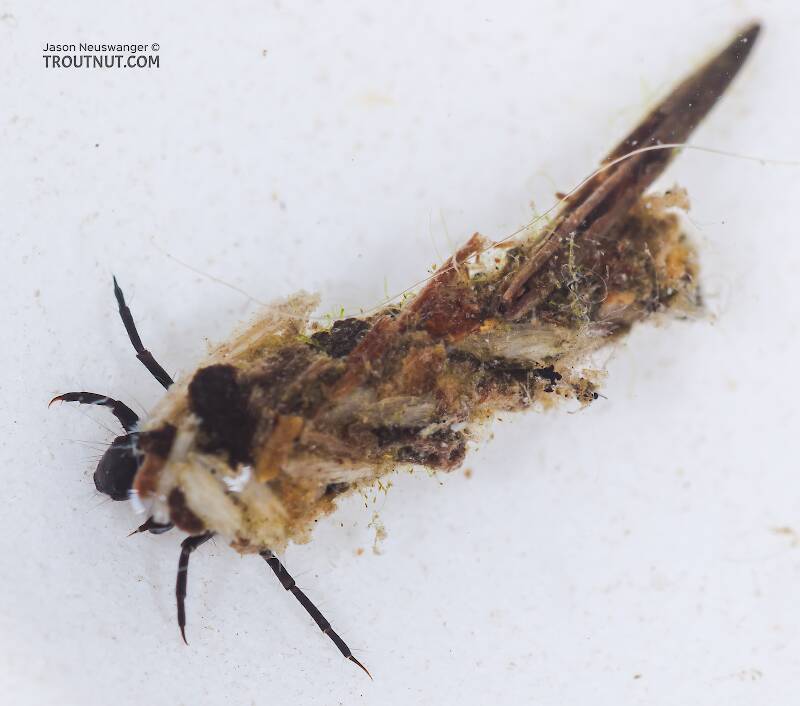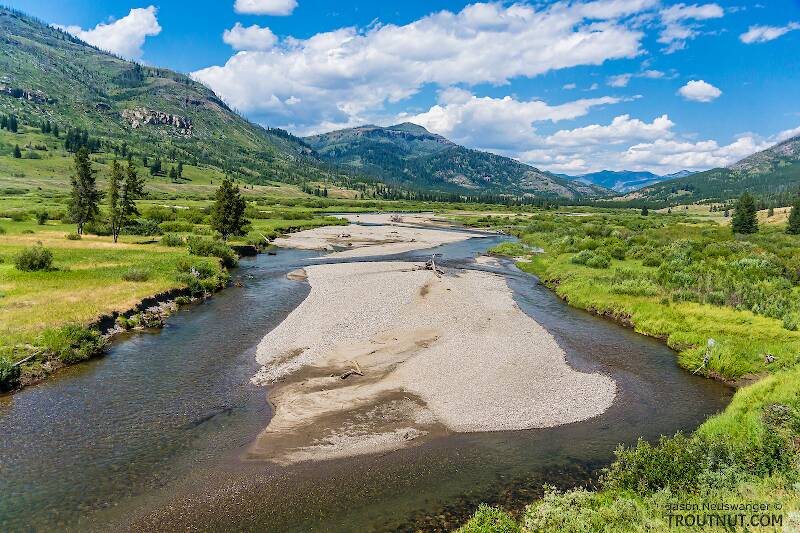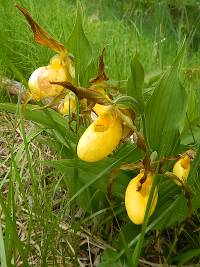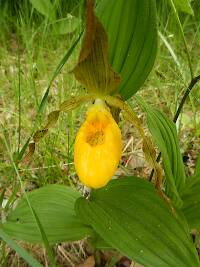
Hex Mayflies
Hexagenia limbata
The famous nocturnal Hex hatch of the Midwest (and a few other lucky locations) stirs to the surface mythically large brown trout that only touch streamers for the rest of the year.
Featured on the forum

This seems to be a young larva of Limnephilus. Although not clear in the picture, several ventral abdominal segments have chloride epithelia.

Troutnut is a project started in 2003 by salmonid ecologist Jason "Troutnut" Neuswanger to help anglers and
fly tyers unabashedly embrace the entomological side of the sport. Learn more about Troutnut or
support the project for an enhanced experience here.
Troutnut on May 30, 2007May 30th, 2007, 7:41 am EDT
On two consecutive evenings on my recent trip to the limestone spring creeks of central Pennsylvania, I ran across a problem I haven't seen in a while: too many bugs.
The first night, it was all sulphur (Ephemerella invaria) spinners. The next night, it was a mix of those and the smaller dorothea sulphurs as both spinners and duns, along with light cahill duns and spinners and at least 5 other mayfly species in lesser numbers. Figuring out what to match was a headache there, too, but it was a bit of a moot point. There were so many insects on the water that any given trout would see 20-50 real bugs float right overhead for every one that it ate.
I caught some fish and drew the most strikes at the beginning and end of the action, when the bugs were at a more manageable density. During the peak it seemed completely futile. Since then, I've been thinking about how I should have responded to the challenge. Here are some ideas I've seen:
Which combination of these ideas (or others I didn't think of) have you tried, and have you found anything that works reliably?
The first night, it was all sulphur (Ephemerella invaria) spinners. The next night, it was a mix of those and the smaller dorothea sulphurs as both spinners and duns, along with light cahill duns and spinners and at least 5 other mayfly species in lesser numbers. Figuring out what to match was a headache there, too, but it was a bit of a moot point. There were so many insects on the water that any given trout would see 20-50 real bugs float right overhead for every one that it ate.
I caught some fish and drew the most strikes at the beginning and end of the action, when the bugs were at a more manageable density. During the peak it seemed completely futile. Since then, I've been thinking about how I should have responded to the challenge. Here are some ideas I've seen:
- Un-match the hatch. Fish something the trout are likely to recognize as food and prefer over whatever they're fixated on, if at al possible. What works well for this? A huge dry? A big streamer? An ant or beetle?
- Fish flies "better than the real thing." I think it was Gary LaFontaine who listed this as a criterion for the ultimate dry fly: something the fish are likely to prefer over the actual insect. Perhaps it's a fly which seems realistic to them but it's more visible than the real thing, and in a way that doesn't make trout suspicious. Does anyone have a pattern they swear by for this role? Maybe a "cluster" fly imitating 2+ spinners on the same hook?
- Fish multiple flies. Fish two or three flies close together on the leader. If they're all the same hatch-matching pattern they just double or triple the odds that the fly the fish randomly chooses will contain your hook. If you're facing a mixed hatch, then you have a shot at fish keyed on different bugs without re-rigging. Of course, if your 3 flies get tangled casting in the dark, the action may be over before you get un-tangled.
- Twitch the fly. This seems like an easy way to make your fly stand out from the crowd without completely sacrificing realism. I had one big brown grab my fly as it was dragging and accelerating through the water on my casting pick-up, after ignoring dozens of drag-free drifts. I'm sure that was an isolated fluke, but it makes me wonder how well-executed motion would work in this situation. Have you found any motions that work well for this?
- Cast nymphs to the risers throughout the activity. I can't resist the temptation to fish a dry when rising fish are around, but the conventional wisdom is that you can catch more and bigger fish when nymphing throughout the hatch. How well does this work in these blanket hatch situations?
- Cast very accurately. For me, this meant getting in close, about 15 feet, in the dark. Some of these fish don't seem willing to move a foot to one side or the other.
- Taking a few shots at every fish or sticking with one fish. Has either method worked much better than the other for you?
Which combination of these ideas (or others I didn't think of) have you tried, and have you found anything that works reliably?
Jason Neuswanger, Ph.D.
Troutnut and salmonid ecologist
Troutnut and salmonid ecologist
Shawnny3 on May 30, 2007May 30th, 2007, 11:21 am EDT
What a nice problem to have, but it can be frustrating. I've found, as you did, that the action just before and after the heaviest part of the hatch is sometimes the easiest to become a part of.
You offer great suggestions, Jason, and I would say that many of the techniques you proffered are effective some of the time, but it's still a puzzle as to the best course in each situation. Problem is, you usually don't have much time to figure out the puzzle, and being hasty will sometimes just leave you with a rats' nest to undo while the fish go nuts.
When time is of the essence, I suggest not wasting time changing fly after fly trying to find the silver bullet. The puzzle is often more a matter of water depth or figuring out where in the pool fish are feeding on what you're throwing at them. Sometimes the little snappers are in the heart of the pool jumping out of the water for size-14 dries while the big boys are feeding on size-18 emergers in 4 inches of riffly water at the head of the pool. Just an example to show that there isn't always just one answer. So if you're confident you have on the fly you want to fish and you know it should catch fish, then set yourself to figuring out where and how it will work.
-Shawn
You offer great suggestions, Jason, and I would say that many of the techniques you proffered are effective some of the time, but it's still a puzzle as to the best course in each situation. Problem is, you usually don't have much time to figure out the puzzle, and being hasty will sometimes just leave you with a rats' nest to undo while the fish go nuts.
When time is of the essence, I suggest not wasting time changing fly after fly trying to find the silver bullet. The puzzle is often more a matter of water depth or figuring out where in the pool fish are feeding on what you're throwing at them. Sometimes the little snappers are in the heart of the pool jumping out of the water for size-14 dries while the big boys are feeding on size-18 emergers in 4 inches of riffly water at the head of the pool. Just an example to show that there isn't always just one answer. So if you're confident you have on the fly you want to fish and you know it should catch fish, then set yourself to figuring out where and how it will work.
-Shawn
Jewelry-Quality Artistic Salmon Flies, by Shawn Davis
www.davisflydesigns.com
www.davisflydesigns.com
Invicta on May 30, 2007May 30th, 2007, 11:37 pm EDT
Jason,
You’ve covered most of the blanket hatch answers with the solutions you listed. For myself I have found that a couple of tricks usually help out when the hatch is simply overwhelming. The choice you have is whether you wish to target the obvious risers (generally smaller fish), or go for something a bit larger lurking in the sidelines. At those times and places when I crave dry fly fishing the techniques listed below have helped, but realize the majority of my fishing is west of the Rockies in either freestone or tail water environments.
For those times that the surface is carpeted with smaller mayflies matching any aspect of the natural (except size) is usually a handicap. Most, if not all the rising trout are close to the surface creating an extremely narrow field of view. The feeding rhythm usually allows several naturals to pass overhead between rises. So unless you have timed your cast extremely well, with more than average accuracy, chances are the fish will never see your artificial. Also with so many naturals on the surface you will probably have a difficult time finding the exact location of your fly. Making a better imitation won’t help here, if you can’t see your fly you won’t know if you are in the correct feeding lane, or if the drift is drag free. Trust me on this next point, age won’t help your eyesight one bit. Typically in a situation like this I find myself using a parachute pattern in the same size as the naturals with a wing of highly visible synthetic material (usually Krystal Flash).
Some swear by appropriately sized attractors for this type of fishing, but I have found that as fishing pressure increases the effectiveness of such patterns suffers. So I stick with a drabber pattern that I tie myself, stay with one fish until I put him down or the light favors moving to another location for better visibility. This is close range casting, with minimal false casting, where you are trying to match the trout’s feeding rhythm with your timing. If it appears that the fish are rising to emergers in the surface film, or nymphs just under the surface I’ll hang a small emerger behind the parachute and see what happens. For caddis hatches I generally use an X-Caddis with a small beadhead trailer. For unmatching the hatch I have found the following to work.
In the right weather and water conditions a small cree-variant has done wonders to stir up fish that otherwise won’t move to any other presentation. You don’t want to have the pattern too large, if the naturals are #18, and a #16 variant is about right. It doesn’t work every time, and you stand a good chance of putting down some trout, but it is fun to watch a pool explode as that little bit of feather dances across the surface. Generally I have found that the use of small terrestrials is most effective when there are fewer naturals on the surface, during warmer weather. Here the emerging mayfly leaves the surface rather quickly, so trout concentrate on cripples and other surface fare. Not going beyond the size range of the naturals, a well placed small ant or beetle imitation will do well for selective summer trout.
You may find that the simplest way to handle the hatch is to choose a cripple and fish it from beginning to end, rather than attempt to change patterns. Sooner or later some of the fish will respond to that type of pattern. And certainly larger of the trout will most likely not participate in surface feeding with the youngsters, but may respond to a cripple floated into a prime holding area. Subsurface patterns will bring better results for larger fish, if presented to the appropriate locations. This becomes specialized fly fishing, and really depends on the species and size you are expecting. There’s no point in trying to dredge out a 20” Brown if the largest trout within rifle shot is a 12” cutthroat.
I also feel that the person who ties their own patterns has an advantage over other anglers as they are able to show even somewhat selective trout something out of the ordinary on heavily pressured waters.
Hope this was of some help… tight lines.
John
You’ve covered most of the blanket hatch answers with the solutions you listed. For myself I have found that a couple of tricks usually help out when the hatch is simply overwhelming. The choice you have is whether you wish to target the obvious risers (generally smaller fish), or go for something a bit larger lurking in the sidelines. At those times and places when I crave dry fly fishing the techniques listed below have helped, but realize the majority of my fishing is west of the Rockies in either freestone or tail water environments.
For those times that the surface is carpeted with smaller mayflies matching any aspect of the natural (except size) is usually a handicap. Most, if not all the rising trout are close to the surface creating an extremely narrow field of view. The feeding rhythm usually allows several naturals to pass overhead between rises. So unless you have timed your cast extremely well, with more than average accuracy, chances are the fish will never see your artificial. Also with so many naturals on the surface you will probably have a difficult time finding the exact location of your fly. Making a better imitation won’t help here, if you can’t see your fly you won’t know if you are in the correct feeding lane, or if the drift is drag free. Trust me on this next point, age won’t help your eyesight one bit. Typically in a situation like this I find myself using a parachute pattern in the same size as the naturals with a wing of highly visible synthetic material (usually Krystal Flash).
Some swear by appropriately sized attractors for this type of fishing, but I have found that as fishing pressure increases the effectiveness of such patterns suffers. So I stick with a drabber pattern that I tie myself, stay with one fish until I put him down or the light favors moving to another location for better visibility. This is close range casting, with minimal false casting, where you are trying to match the trout’s feeding rhythm with your timing. If it appears that the fish are rising to emergers in the surface film, or nymphs just under the surface I’ll hang a small emerger behind the parachute and see what happens. For caddis hatches I generally use an X-Caddis with a small beadhead trailer. For unmatching the hatch I have found the following to work.
In the right weather and water conditions a small cree-variant has done wonders to stir up fish that otherwise won’t move to any other presentation. You don’t want to have the pattern too large, if the naturals are #18, and a #16 variant is about right. It doesn’t work every time, and you stand a good chance of putting down some trout, but it is fun to watch a pool explode as that little bit of feather dances across the surface. Generally I have found that the use of small terrestrials is most effective when there are fewer naturals on the surface, during warmer weather. Here the emerging mayfly leaves the surface rather quickly, so trout concentrate on cripples and other surface fare. Not going beyond the size range of the naturals, a well placed small ant or beetle imitation will do well for selective summer trout.
You may find that the simplest way to handle the hatch is to choose a cripple and fish it from beginning to end, rather than attempt to change patterns. Sooner or later some of the fish will respond to that type of pattern. And certainly larger of the trout will most likely not participate in surface feeding with the youngsters, but may respond to a cripple floated into a prime holding area. Subsurface patterns will bring better results for larger fish, if presented to the appropriate locations. This becomes specialized fly fishing, and really depends on the species and size you are expecting. There’s no point in trying to dredge out a 20” Brown if the largest trout within rifle shot is a 12” cutthroat.
I also feel that the person who ties their own patterns has an advantage over other anglers as they are able to show even somewhat selective trout something out of the ordinary on heavily pressured waters.
Hope this was of some help… tight lines.
John
Macgruber on May 31, 2007May 31st, 2007, 8:03 am EDT
the only hatch i've had that problem with was sulphurs as well..... don't have a solution, as the couple times it happened i didn't have the answers apparently, but that was before i switched to green sulphurs-- the color probably varies nationwide, and worldwide, but in western sconnie, they are typically apple green......
i did manage a few fish swinging a wet on the bottom of the drift.... the fish seemed to like the motion- and one went for the dry moving across the water as well......
i did manage a few fish swinging a wet on the bottom of the drift.... the fish seemed to like the motion- and one went for the dry moving across the water as well......
Quick Reply
Related Discussions
Topic
Replies
Last Reply
0
May 25, 2012
by Jmd123
by Jmd123




